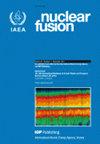Anisotropic regularization for inversion of fast-ion loss detector measurements
IF 4
1区 物理与天体物理
Q1 PHYSICS, FLUIDS & PLASMAS
引用次数: 0
Abstract
We introduce an anisotropic regularization framework for the reconstruction of distribution functions from measurements, utilizing an approach that applies distinct regularization techniques such as non-negative constrained Tikhonov, total variation, and Besov-space priors, either penalizing the one-norm or the two-norm, in each dimension to reflect the anisotropic characteristics of the multidimensional data. This method, applied to fast-ion loss detector (FILD) measurements, demonstrates a significant improvement over conventional nonnegative-constrained zeroth-order Tikhonov regularization because the prior information of the form of the distribution allows better reconstructions. The validity of the approach is corroborated through FILD measurements of prompt fast-ion losses in an ASDEX Upgrade discharge, where the reconstructed distribution function agrees well with the prompt-loss distribution predicted by ASCOT simulations. Moreover, we develop a composite quality metric, Q, that combines the mean squared error and the Jaccard index for a comprehensive evaluation of reconstruction accuracy and spatial fidelity. Finally, anisotropic regularization is applied to FILD measurements at ASDEX Upgrade to study fast-ion acceleration by edge-localized modes. The refined analysis resolves fine structure in the pitch of the accelerated ions and clearly shows that some ions are accelerated to over twice the injection energy.用于快速离子损耗探测器测量反演的各向异性正则化
我们为从测量结果重建分布函数引入了一个各向异性正则化框架,该框架采用的方法应用了不同的正则化技术,如非负约束 Tikhonov、总变异和 Besov 空间先验,在每个维度上对单正则或双正则进行惩罚,以反映多维数据的各向异性特征。这种方法应用于快速离子损耗探测器(FILD)测量,与传统的非负约束零阶 Tikhonov 正则化相比有显著改进,因为分布形式的先验信息可以实现更好的重构。通过对 ASDEX 升级放电中瞬时快离子损耗的 FILD 测量证实了该方法的有效性,重建的分布函数与 ASCOT 模拟预测的瞬时损耗分布非常吻合。此外,我们还开发了一种综合质量指标 Q,它结合了均方误差和 Jaccard 指数,用于全面评估重建精度和空间保真度。最后,将各向异性正则化应用于 ASDEX 升级的 FILD 测量,以研究边缘定位模式的快速离子加速。细化分析解析了加速离子间距的精细结构,并清楚地表明一些离子被加速到注入能量的两倍以上。
本文章由计算机程序翻译,如有差异,请以英文原文为准。
求助全文
约1分钟内获得全文
求助全文
来源期刊

Nuclear Fusion
物理-物理:核物理
CiteScore
6.30
自引率
39.40%
发文量
411
审稿时长
2.6 months
期刊介绍:
Nuclear Fusion publishes articles making significant advances to the field of controlled thermonuclear fusion. The journal scope includes:
-the production, heating and confinement of high temperature plasmas;
-the physical properties of such plasmas;
-the experimental or theoretical methods of exploring or explaining them;
-fusion reactor physics;
-reactor concepts; and
-fusion technologies.
The journal has a dedicated Associate Editor for inertial confinement fusion.
 求助内容:
求助内容: 应助结果提醒方式:
应助结果提醒方式:


